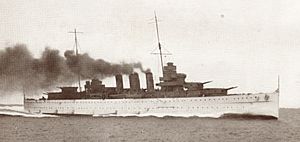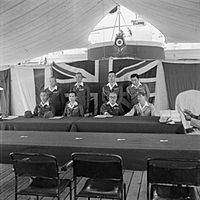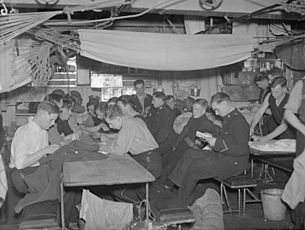HMS Cumberland (57) facts for kids

HMS Cumberland
|
|
Quick facts for kids History |
|
|---|---|
| Name | Cumberland |
| Builder | Vickers-Armstrong, Barrow in Furness |
| Laid down | 18 October 1924 |
| Launched | 16 March 1926 |
| Commissioned | 23 February 1928 |
| Recommissioned | 1951 |
| Decommissioned | 1946 |
| Identification | Pennant number 57 |
| Fate | Sold for scrap 1959 |
| General characteristics | |
| Class and type | County-class heavy cruiser |
| Displacement |
|
| Length | 630 ft (190 m) |
| Beam | 68 ft 3 in (20.80 m) |
| Draught | 16 ft 3 in (4.95 m) |
| Propulsion |
|
| Speed | 31.5 knots (58.3 km/h) |
| Range | 3,100 nautical miles at 31.5 knots (5,740 km at 58 km/h), 13,300 nautical miles at 12 knots (24,600 km at 22 km/h); 3,400 tons (3,450 t) fuel oil |
| Complement | 679 (710 as flagship) |
| Armament |
|
| Armour |
|
| Aircraft carried | Three aircraft with one catapult, removed in 1942 |
HMS Cumberland was a powerful warship known as a heavy cruiser. It was part of the Royal Navy, which is the United Kingdom's navy. This ship played an important role during the Second World War.
Cumberland was built by a company called Vickers-Armstrongs in Barrow-in-Furness in 1926. It was a large ship, about 192 meters (630 feet) long. It could travel very fast, reaching speeds of over 58 kilometers per hour (32 knots).
Contents
Life of a Warship: HMS Cumberland's Journey
HMS Cumberland served in many different parts of the world. It was a busy ship throughout its career.
Early Service: China and South America
From 1928 to 1938, Cumberland was stationed far away in Asia, with the 5th Cruiser Squadron on the China Station. This meant it helped protect British interests and trade routes in that region. In 1935, it returned to the UK for some upgrades. Later, in 1938, it moved to the South American station, joining the 2nd Cruiser Squadron.
World War II: The Battle of the River Plate
When the Second World War began in 1939, Cumberland was in South America. It was part of a group of ships called Force G. In December 1939, Cumberland had to go to the Falkland Islands for repairs. This meant it couldn't join the other ships right away.
Without Cumberland, three other British ships – HMS Exeter, Ajax, and Achilles – fought a famous battle. They faced a strong German warship called Admiral Graf Spee in the Battle of the River Plate on December 13.
Cumberland quickly sailed to help, traveling over 1,800 kilometers (1,014 nautical miles) in just 34 hours! It arrived at the River Plate on December 14. The German ship Admiral Graf Spee had gone into the neutral port of Montevideo and was trapped there. With Cumberland and the other British ships waiting outside, the German crew decided to sink their own ship on December 17 rather than let it be captured.
Service in South Africa
After this big battle, Cumberland sailed to Simonstown, South Africa. It spent time there for repairs and upgrades. Then, it helped protect convoys, which are groups of merchant ships traveling together, along the African coast. These convoys were heading to the Middle East.
In July, Cumberland and its sister ship, HMS Cornwall, were sent to hunt for a German merchant raider called Thor. During this time, Cumberland stopped a French merchant ship that was carrying ammunition. The French crew sank their own ship to prevent it from falling into enemy hands. Later that month, Cumberland was involved in an attack on Dakar and was damaged by French coastal guns.
Dangerous Arctic Convoys
In October 1941, Cumberland joined the Home Fleet and began escorting Arctic convoys. These were very dangerous missions. The convoys delivered vital supplies to the Soviet Union through icy, stormy seas, often under attack from German forces. Cumberland continued this important work until January 1944. For its bravery, it earned a special honor called Arctic 1942-1943.
Operations in the Far East
After its time in the Arctic, Cumberland was sent to the Far East. It became part of the Eastern Fleet. In September 1944, it took part in raids on Northern Sumatra. During its service in this area, Cumberland earned two more battle honors: Sabang 1944 and Burma 1945. On February 7, 1945, the ship returned to Simonstown for rudder repairs.
Post-War Life and Special Roles
After the war, Cumberland returned to the United Kingdom in November 1945. It helped transport troops until June 1946. Then, it was put into reserve, meaning it was kept ready but not actively used, until 1949.
From 1949 to 1951, Cumberland was refitted at Devonport. It was changed to become a special ship for testing new types of guns. It lost its large 8-inch gun turrets. Instead, it had new, experimental automatic gun turrets installed. These were being tested for future warships.
In 1956, Cumberland even played itself in a film called The Battle of the River Plate. It showed how it arrived quickly from the Falklands to help after the battle. Even though its guns looked different by then, it was still recognizable as one of the last three-funnelled heavy cruisers.
Between 1955 and 1956, Cumberland was also used to test defenses against atomic and hydrogen bombs. Its first trip for these tests was delayed due to "defects" in its engine room. Later, it returned to port quickly after another unexplained "defect" in its main gearbox. Some people suspected sabotage.
HMS Cumberland was finally taken out of service in 1958. It arrived at a scrapping yard in Newport on November 3, 1958, where it was taken apart.
Images for kids





